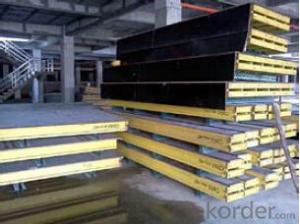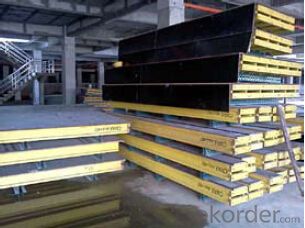Plywood Formwork system for formwork and scaffolding
- Loading Port:
- Tianjin
- Payment Terms:
- TT OR LC
- Min Order Qty:
- 50 m²
- Supply Capability:
- 1000 m²/month
OKorder Service Pledge
Quality Product, Order Online Tracking, Timely Delivery
OKorder Financial Service
Credit Rating, Credit Services, Credit Purchasing
You Might Also Like
Plywood --- make perfect concrete surface
WISA-Form Birch is a coated special plywood using in the formwork systems where high
requirements are set on the concrete surface and the times of reuses.
With CNBM timber beam & WISA plywood, the formwork is low weight but high load capacity, it is
widely used in construction.
Characteristics:
◆ Component with high standardization.
◆ Assembling in site, flexible application.
◆ Light weight, easy transportation and storage.


- Q: Can steel formwork be used for both interior and exterior structures?
- Yes, steel formwork can be used for both interior and exterior structures. Steel formwork is versatile and can withstand various environmental conditions, making it suitable for both indoor and outdoor construction projects.
- Q: What are the advantages and disadvantages of the application of the steel formwork and the plywood formwork in the construction?
- Economic aspect: the steel formwork one-time investment cost is high, but the turnover number is more; the wood template cost is low, but the turnover number is less
- Q: What are the common design considerations for steel formwork?
- Some common design considerations for steel formwork include the strength and stability of the structure, ease of assembly and disassembly, dimensional accuracy, resistance to deformation or warping, durability against repeated use, compatibility with other construction materials, and ability to accommodate various concrete mix designs and pouring techniques. Additionally, factors such as cost-effectiveness, safety, and environmental impact are also taken into account during the design process.
- Q: How does steel formwork contribute to the overall construction process?
- Steel formwork plays a crucial role in the overall construction process by providing a strong and durable framework for concrete structures. It offers numerous advantages over traditional wooden formwork, making it a preferred choice for many construction projects. Firstly, steel formwork is highly durable and can withstand multiple uses, resulting in cost savings as it does not require frequent replacement. This longevity also contributes to sustainability in construction, reducing waste and environmental impact. Secondly, steel formwork offers excellent strength and stability, ensuring the integrity of the concrete structure. It can withstand high pressures and vibrations during the pouring and curing process, resulting in a smooth and even finish. The precision and accuracy provided by steel formwork also help in achieving the desired dimensions and shape of the concrete structure. Moreover, steel formwork is highly adaptable and customizable, allowing for flexibility in design and construction. It can be easily adjusted or modified to accommodate changes in the architectural or engineering plans, saving time and effort. This flexibility also enables the construction of complex and intricate structures, such as curved or sloped walls, which would be challenging to achieve with traditional formwork methods. Another significant advantage of steel formwork is its reusability. Unlike wooden formwork, which is typically discarded after a few uses, steel formwork can be dismantled, cleaned, and reused on multiple projects. This not only reduces construction costs but also minimizes waste generation and promotes sustainable construction practices. In addition to its durability and adaptability, steel formwork offers improved construction speed and efficiency. Its lightweight nature allows for easy handling and assembly, reducing labor and construction time. The smooth surface of steel formwork also aids in quick and efficient concrete pouring and finishing. Overall, steel formwork contributes to the overall construction process by providing a sturdy, versatile, and reusable framework for concrete structures. Its durability, strength, adaptability, and efficiency make it an indispensable tool in modern construction, ensuring the successful and timely completion of projects while maintaining high-quality standards.
- Q: Can steel formwork be used in residential housing projects?
- Certainly, residential housing projects can make use of steel formwork. Steel formwork, a robust and flexible formwork system, is widely employed in construction endeavors, including those pertaining to residential housing. It boasts numerous advantages, such as its exceptional strength, reusability, and capacity to fabricate intricate shapes and designs. Particularly well-suited for projects demanding precision and resilience, steel formwork finds utility in various aspects of residential housing construction, encompassing walls, columns, slabs, and beams. The inclusion of steel formwork in residential housing projects can enhance construction efficiency, diminish labor and material expenses, and ensure consistently high-quality outcomes.
- Q: What are the safety considerations when working with steel formwork?
- When working with steel formwork, there are several safety considerations that should be taken into account. First and foremost, workers must ensure that the formwork is properly installed and secured to prevent any collapse or instability. It is essential to follow manufacturer's instructions and guidelines for assembly and disassembly. Additionally, workers should be equipped with proper personal protective equipment (PPE) such as hard hats, gloves, and safety glasses to protect themselves from potential hazards such as falling objects or metal shards. Adequate training and supervision are also crucial to ensure that workers are aware of the potential risks and hazards associated with steel formwork and know how to work safely. Regular inspections of the formwork should be conducted to identify any signs of damage or deterioration that could compromise its structural integrity. Finally, proper communication and coordination among the team members is essential for a safe working environment when using steel formwork.
- Q: What type of steel is used in steel formwork?
- Typically, a high-strength, low-alloy (HSLA) steel is employed in steel formwork due to its excellent strength, durability, and resistance to corrosion. HSLA steel is frequently utilized in construction projects that demand a robust and enduring material capable of enduring the challenges of formwork. Moreover, the steel employed in formwork is frequently subjected to special coatings or finishes to further augment its ability to resist rust and other types of deterioration.
- Q: How does steel formwork handle concrete pumping and placing?
- Steel formwork is a highly durable and versatile construction material that is well-suited for handling concrete pumping and placing. Due to its strength and rigidity, steel formwork can withstand the pressure exerted by the concrete during the pumping process without any deformations or failures. It provides a stable and secure framework, ensuring that the concrete is accurately placed and consolidated. Steel formwork also offers excellent resistance to the abrasiveness and corrosiveness of concrete. This is especially important during the pumping and placing stages, as the concrete is often mixed with various additives and can have a high alkaline content, which can be destructive to other types of formwork materials. However, steel formwork is unaffected by these chemical reactions, making it a reliable choice for handling concrete pumping and placing. Moreover, steel formwork is easily adjustable and adaptable, allowing for the creation of complex shapes and designs. It can be easily assembled and disassembled, enabling efficient and quick reconfiguration of the formwork system to accommodate different concrete pumping and placing requirements. This flexibility makes steel formwork a preferred choice for projects that involve intricate or customized concrete structures. Additionally, steel formwork provides a smooth and consistent surface finish to the concrete, ensuring that the final structure meets the desired aesthetic and functional requirements. The rigid nature of steel formwork helps prevent any deformations or irregularities in the concrete surface, resulting in a high-quality and visually appealing end product. In summary, steel formwork is an ideal choice for handling concrete pumping and placing due to its strength, durability, resistance to chemical reactions, adaptability, and ability to provide a smooth finish. It offers a reliable and efficient solution for construction projects that require accurate and precise concrete placement.
- Q: What are the advantages of using modular steel formwork systems?
- There are several advantages of using modular steel formwork systems in construction projects. Firstly, modular steel formwork systems offer high levels of accuracy and precision. These systems are designed with pre-fabricated panels and components that fit together seamlessly, ensuring precise alignment and consistent results. This accuracy helps in achieving a high-quality finish and reduces the need for rework or corrections. Secondly, modular steel formwork systems are highly versatile and adaptable. They can be easily adjusted and customized to meet the specific requirements of different projects, including various shapes, sizes, and configurations. This flexibility allows for efficient construction of complex structures and helps in optimizing the use of materials. Additionally, modular steel formwork systems are incredibly durable and long-lasting. Steel is a strong and robust material that can withstand heavy loads and extreme weather conditions, making it ideal for construction purposes. This durability ensures that the formwork system can be used repeatedly, reducing the need for frequent replacements and saving costs in the long run. Moreover, modular steel formwork systems offer significant time savings during the construction process. These systems can be quickly assembled and dismantled, allowing for faster construction cycles and improved project timelines. The ease of use and efficient installation of these systems help in reducing labor requirements and increasing productivity on-site. Lastly, modular steel formwork systems promote sustainability in construction. Steel is a recyclable material, and using modular systems reduces the amount of waste generated during the construction process. Additionally, the reusability of the formwork system reduces the consumption of timber, which is often used in traditional formwork methods. In conclusion, the advantages of using modular steel formwork systems include high accuracy, versatility, durability, time savings, and sustainability. These systems provide construction projects with efficient and cost-effective solutions, ensuring high-quality results and long-term benefits.
- Q: Are there any safety precautions to consider when using steel formwork?
- Yes, there are several safety precautions to consider when using steel formwork. 1. Proper training: It is essential that all workers using steel formwork receive proper training on the correct handling and assembly procedures. This includes understanding the safe load capacity, proper installation techniques, and dismantling processes. 2. Inspection and maintenance: Regular inspection and maintenance of the steel formwork is crucial to ensure its structural integrity. Any signs of damage, such as cracks, bent parts, or loose connections, should be immediately addressed and repaired. 3. Personal protective equipment (PPE): All workers involved in the steel formwork operations should wear appropriate PPE, including helmets, safety goggles, gloves, and steel-toe boots. This will protect them from potential hazards, such as falling objects, sharp edges, or accidental contact with the formwork. 4. Secure and stable platform: It is important to provide a secure and stable platform for workers to access and work on the steel formwork. This may involve using scaffolding, ladders, or elevated work platforms that are properly secured and meet safety standards. 5. Fall protection: Implementing fall protection measures is crucial when working at heights. This may include installing guardrails, safety nets, or personal fall arrest systems to prevent falls and protect workers from serious injuries. 6. Material handling: Proper lifting techniques should be followed when handling steel formwork components to prevent strain or muscle injuries. The use of mechanical lifting equipment, such as cranes or forklifts, can also help minimize the risk of accidents. 7. Communication and coordination: Clear communication and coordination among workers involved in the steel formwork operations is vital to ensure everyone's safety. This includes establishing a clear chain of command, using hand signals or radios for communication, and conducting regular safety meetings to address any concerns or issues. By following these safety precautions, the risk of accidents, injuries, and damage can be significantly reduced when using steel formwork.
Send your message to us
Plywood Formwork system for formwork and scaffolding
- Loading Port:
- Tianjin
- Payment Terms:
- TT OR LC
- Min Order Qty:
- 50 m²
- Supply Capability:
- 1000 m²/month
OKorder Service Pledge
Quality Product, Order Online Tracking, Timely Delivery
OKorder Financial Service
Credit Rating, Credit Services, Credit Purchasing
Similar products
Hot products
Hot Searches
Related keywords

















